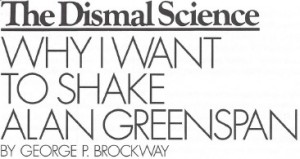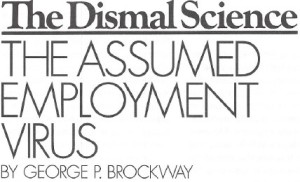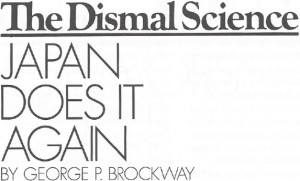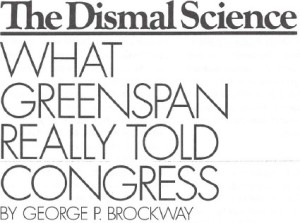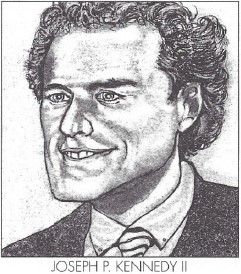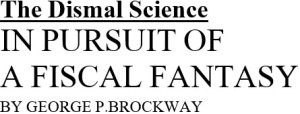By George P. Brockway, originally published August 23, 1999
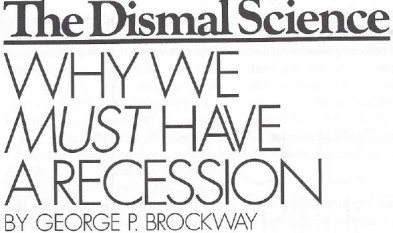 PROBABLY at least once in every one of the 18 years I’ve been writing this column, I have made fun of an obiter dictum[1] of President Calvin Coolidge: “When many people are out of work, unemployment results.” I think it is still good for a laugh, although of course it is undeniably true, and so is my variant: When many people raise prices, inflation results.
PROBABLY at least once in every one of the 18 years I’ve been writing this column, I have made fun of an obiter dictum[1] of President Calvin Coolidge: “When many people are out of work, unemployment results.” I think it is still good for a laugh, although of course it is undeniably true, and so is my variant: When many people raise prices, inflation results.
I’ll go a step further: It is only when many people raise prices that we (including the Federal Reserve Board) know we have inflation. And I’ll take another small step for man but a momentous step for understanding the economy: Except in time of war or disaster, we have inflation only when the central bank (the Federal Reserve Board) brings it about.
Let’s heed Deep Throat‘s advice and follow the money.
If you (as an individual or a corporation) plan to start anew business, or to expand an old one, or to merely keep an old one going, the first thing you have to do is look for financing. As Iago said, put money in thy purse.
You can get money in lots of ways. You can borrow it from a bank or from a venture fund. You can sell shares or unneeded assets to a more venturesome fund or to a friend or on an exchange. You can use money you have on hand or your company has on hand. It does not make much difference how you finance your enterprise, but you have to do it, and it will cost you. Even money that you or the company may have on hand has an opportunity cost-that is, what you might have made if you had invested it in some other way.
In short, borrowing comes first and its price depends on the interest rate. Interest rates have to be set before the financing of any good or service is agreed to; financing precedes manufacturing; manufacturing precedes delivery to customers; delivery requires prices, which must be set to cover all the previous costs, plus, it is hoped, a profit. This is the way capitalist business runs, and there is no better way to run it.
To be sure, different companies follow different routines to achieve the same result. Many arrange a line of credit with a bank to prepare for the needs of a year or a season or a project. Special projects may be planned all at once. An automobile company may glimpse a chance for a new sports utility maxivan. All that exists at the beginning is a price range, a schedule of standard specifications, and a menu of desired special features. The engineering and design departments see what they can do; the sales department does market research; but the car is not built unless the finance department can be reasonably sure of necessary monetary support at a feasible interest rate.
That is not to say that finance is more important than (or even as important as) engineering or design or advertising or sales. It is simply to say that finance is primary. After all, the name of our system is finance capitalism.
I have been belaboring the obvious because it is essential for understanding one of the crucial problems of our time-the relation of the interest rate to the price level in a modem economy. The interest rate has an effect on prices, because it is a cost, and costs have to be covered by prices. The causation goes only from interest rate to prices, not vice versa. Prices may affect the sensibilities of the Federal Reserve’s governors, and they do in fact set the interest rate. Nevertheless, this is not a chicken-and-egg question.
A chicken makes an egg, and the egg makes a chicken, and that chicken makes an egg, and so on. Leaving aside the Reserve’s sensibilities, prices do not affect the interest rate, because the interest rate is set before prices are.
It is possible to assemble the statistics and plot curves showing the fluctuations of the interest rate and the price level. Depending on where you start, the peaks and valleys of one will necessarily follow those of the other with, as they say, a lag. If you then start with the other one, their roles will be reversed, and the lag will be different. There is absolutely no way of telling from the statistics or the graphs themselves which “really” comes first, the interest rate or the price level.
In this, the question is like that of the three-way colonial trade (guns and calico for slaves, slaves for cotton and rum; cotton and rum for guns and calico). These are not statistical problems; they are analytical problems. We know from our analysis that the interest rate affects prices, but there is no way for prices to affect the interest rate.
Well, I’ll take that, or a little of it, back. Banks and other lenders have to make ends meet, too; so their prices (the interest rates) have to be high enough to cover their labor, capital and rent costs. But the basic price of their product is set by the Federal Reserve Board. Their overheads merely account for the differences between the rates of your friendly neighborhood banker and those of the snobbish bank in the next town. The dictum stands: Interest rates affect prices, but the Reserve, not prices, affects interest rates.
The business press frequently writes that in certain situations (usually good news, like increasing employment and more prosperous businesses) the Reserve “will have to raise rates,” but there is no natural law or legal requirement that forces it to take the specified action. If the Reserve does raise rates, it is because of the governors’ own free will, guided by their own economic theory, which in this case happens to be fallacious.
PLEASE NOTE that it does not matter whether inflation is thought to be demand-pull or cost-push. A strong argument can be made that in a modem economy inflation, when it occurs, is practically always cost-push. For demand-pull inflation to work, supply has to be rigidly limited, and in a modem economy there is practically nothing that cannot be readily and indefinitely replicated within a reasonable span of time.
In other words, while the hallowed law of supply and demand was plausible enough in the isolated market towns of Adam Smith‘s day, it no longer is absolute —except in the narrow confines of Wall Street, where the supply of investment grade securities is strictly limited. Even international cartels controlling natural resources, such as the Organization of Petroleum Exporting Countries, are of bounded effectiveness because of the development of substitutes and the threat of military reprisal.
To be sure, the Federal Reserve worries publicly about the supply of labor, and that is certainly at least biologically limited, although relaxed immigration laws could provide short-run solutions and expanded education could extend the long run. Yet the experience of the last few years should have taught us that neither the wisest statesmen nor the most erudite economists have the faintest idea where or whether there actually is a natural rate of unemployment (that most barbarous notion), beyond which inflation must rage uncontrolled.
However all this may be, the fact remains that the interest rate must be agreed to by each enterprise before the enterprise is able to make a responsible attempt at setting its own prices. Thus the price level, an aggregation of all the prices in the economy, is systematically subsequent to the interest rate. Following the money, we see that when the interest rate goes up so does the price level.
No precise formula guides the process. Some entrepreneurs will hold their prices down and be satisfied with a lower profit. Some will manage to cut other costs technological, administrative, sales, advertising, and so on. In general, though, even a small interest hike will result in a noticeable hike in the price level.
In any case, the country is full of inflation hawks-and that includes many governors of the Federal Reserve Board -who are constantly on the lookout for the most obscure forecast of the inflation they fear. Recently they raised the rate, and they threaten to raise it further, despite their admission that there is no significant evidence of coming inflation. Instead, there is much talk of pre-emptive strikes, and of the importance of being ahead of the curve. Indeed, it is widely said that the Reserve must act now.
What happens in these circumstances? The price level inches up, and actual inflation shows itself. The hawks demand a further interest rate increase. The scene is like Zeno’s paradox of Achilles and the tortoise, except that the Achilles of the interest rate can’t catch up with the tortoise of inflation, because Achilles is carrying the tortoise and even pushing it out ahead of him.
Well, we’ve seen how the story ends. In fact, we’ve seen the ending nine times since World War II. Raising the interest rate can only slow down inflation if the Reserve keeps raising it until the whole economy is put into reverse-until, that is, millions of men and women lose their jobs, hundreds of thousands of businesses go bankrupt, and public works languish.
We’re on our way. If we keep it up, we must have a recession. When former Federal Reserve Chairman Paul A. Volcker was asked if his policies might lead to recession, he replied, “Yes, and the sooner the better.” He showed how it was done. Why do we have to do it again?
The New Leader
[1] Ed: Really? “Obiter dictum”? Really?
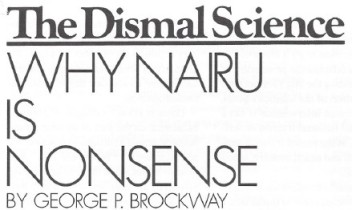
 ONE OF THE mysteries of life in the United States today is why we are not in the midst of a raging inflation, a depressing recession, or both. The answer, though, is staring us in the face.
ONE OF THE mysteries of life in the United States today is why we are not in the midst of a raging inflation, a depressing recession, or both. The answer, though, is staring us in the face.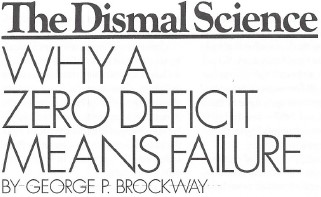 I DON’T want to alarm anyone, but I think it important for us to realize that the United States of America is about to sail into unfamiliar waters. What is more, those waters are inaccurately charted.
I DON’T want to alarm anyone, but I think it important for us to realize that the United States of America is about to sail into unfamiliar waters. What is more, those waters are inaccurately charted. Greenspan replied that he did not know enough about the people Jackson mentioned to use them as a basis for policy, but he acknowledged that they exist. His acknowledgment is my scoop for this week. For I submit that an economy incapable of providing proper jobs for 15 or 20 per cent of its work force is not an adequate economy. It may be “prosperous,” but it does not come close to doing what an economy ought to do. So we have a fourth crosscurrent to reckon with as we approach the waters whose charts are questionable.
Greenspan replied that he did not know enough about the people Jackson mentioned to use them as a basis for policy, but he acknowledged that they exist. His acknowledgment is my scoop for this week. For I submit that an economy incapable of providing proper jobs for 15 or 20 per cent of its work force is not an adequate economy. It may be “prosperous,” but it does not come close to doing what an economy ought to do. So we have a fourth crosscurrent to reckon with as we approach the waters whose charts are questionable.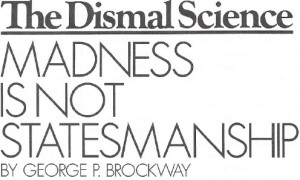 I SUBMIT that it’s time to give it up, quit, call a halt, put an end to the nonsense and the grief it has caused. The charade has had a run of almost 30 years. That is surely long enough for any group of people to toy with the wealth, health and happiness of their fellows.
I SUBMIT that it’s time to give it up, quit, call a halt, put an end to the nonsense and the grief it has caused. The charade has had a run of almost 30 years. That is surely long enough for any group of people to toy with the wealth, health and happiness of their fellows.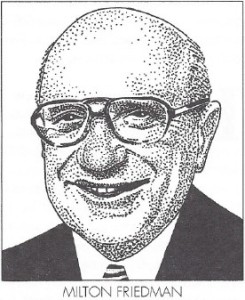 As the natural rate theories began to unfold, their beauty, not to say elegance, began to be appreciated. For, look you: If there is a natural rate of unemployment, the most difficult and most important questions of economics-those that have to do with people-are answered. Better, they’re made to disappear; there’s no point in asking them.
As the natural rate theories began to unfold, their beauty, not to say elegance, began to be appreciated. For, look you: If there is a natural rate of unemployment, the most difficult and most important questions of economics-those that have to do with people-are answered. Better, they’re made to disappear; there’s no point in asking them.